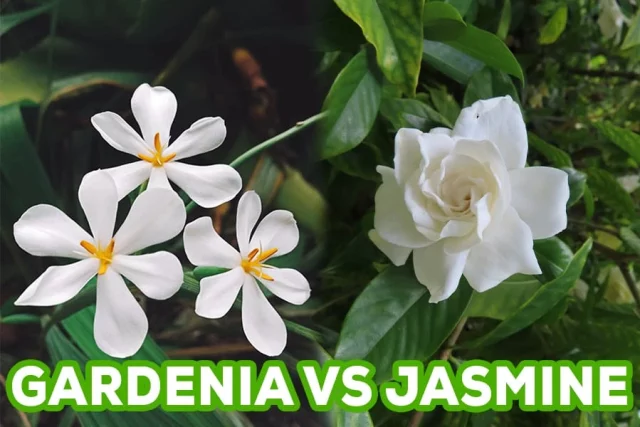When it comes to fragrance, there are two types of flowers: gardenias and jasmine. Gardenias are often considered a more sophisticated scent, while jasmine is more romantic.
So, which should you choose? It can be challenging to decide which one is the best option.
To make the best decision, you must understand the differences between these two flowers. Both flowers have unique qualities that make them special. Here is a guide to help you choose the best scent for your needs.
Gardenia Vs. Jasmine
The two flowers are sweet-smelling flowers and might look similar, but they have some key differences. Jasmine is a vine that proliferates and can be invasive. On the other hand, Gardenia is a shrub that takes a little longer to grow but is less invasive.
Jasmine has smaller blooms than Gardenia, and the fragrance of jasmine is often delicate; Jasmine has a sweet and floral scent. On the other hand, Gardenia blooms are more prominent, and the aroma is more intense and heavy.
Jasmine Plant
The jasmine plant is an evergreen vine hardy in USDA zones 8-10. It can grow up to 15 feet long and produces fragrant white flowers. The home garden often covers arbors, trellises, and fences.
Jasmine makes a good groundcover in tropical climates and can be used as a topiary plant. Jasmine plants are drought tolerant and do well in full sun or partial shade.
They can be grown from seed or cuttings. Jasmine is an excellent choice for a butterfly garden.
The leaves are opposite or sub-opposite, simple, and entire; the flowers fragrant, with five petals.
There are many different types of jasmine, which vary in terms of their fragrance, size, and growing requirements.
There are over 200 species in all and are mainly native to Asia, though a few are from Africa. Jasmine can be evergreen or deciduous.
There are three main types of jasmine: Arabian, Chinese and Indian. Arabian jasmine is the most fragrant type used in perfumes, while Chinese jasmine is the most popular type for tea. Indian jasmine is used to make a type of rice pudding called kheer.
Gardenia Plant
Gardenias are tropical plants that you can find in many warm climates worldwide. There are about 200 species of Gardenia, most of which are shrubs. Gardenias are well known for their beautiful flowers, white or yellow, and intense fragrance.
One of the best things about gardenias is their fragrance. Gardenias are also an excellent choice for pollinators. Butterflies and bees love the nectar in their flowers.
Gardenias are a beautiful addition to any garden. They are shrubs that grow best in warm climates, and they have large, fragrant flowers. They are perfect for adding a touch of elegance to any setting.
Gardenias are not challenging to grow, but they require some special care. They need moist soil and partial shade, and they should be fertilized regularly.
Gardenias are a popular choice for gardens and landscaping because they thrive in sunny and shady areas.
In colder climates, gardenias can be grown in containers and brought inside during winter.
There are many different types of Gardenia, but the most popular is the Gardenia jasminoides. This type of Gardenia is native to Asia and Australia and is known for its beautiful white flowers.
The Similarities Between Jasmine And Gardenia
The jasmine and gardenia plants are two of the most popular flowers globally. They are both beautiful, fragrant, and versatile plants that can be used in various ways. There are several similarities between Jasmine and Gardenia.
- They are both white flowers that grow in the tropics.
- They both have a sweet smell. And you can use them both in perfumes and aromatherapy.
- Their petals are often dried and used in tea.
- They both have fragrant flowers that you can use in arrangements or standalone decorations.
- They also both have edible fruits that can be eaten raw or cooked.
What Is The Difference Between Jasmine And Gardenia?
However, there are some significant differences between these two plants as well:
Flowering Season
Both jasmine and gardenia plants flower during different times of the year. Jasmine typically blooms in early spring and extends into fall(a pretty long period), while gardenia flowers during the late spring and end in summer(a shorter period).
Size
Jasmine plants are typically smaller than gardenia plants. They can grow anywhere from 2 to 15 feet tall, while gardenia plants can reach heights of up to 5 feet.
Fragrance
The most apparent difference between jasmine and Gardenia is their scent. Jasmine has a sweet, floral scent, while Gardenia has a more potent, heady fragrance reminiscent of green apple.
Flower Shape
Gardenia flowers are white and have an oval shape with pointed tips. They grow on a bush and can get up to 6 inches wide.
On the other hand, jasmine is a white or sometimes yellow flower with a sweet fragrance. It has a tubular flower and typically blooms from spring to summer.
Gardenias are both single and double-flowered, while Jasmines are only single-flowered. Gardenias also have thicker petals than jasmine flowers.
Leaves
The leaves of jasmine and gardenia plants are different, but both are evergreen shrubs. Jasmine leaves are opposite, while gardenia leaves are alternate.
Gardenia leaves are also more pointed and have a smooth edge, while jasmine leaves are rounder and have a toothed edge.
Gardenia leaves are longer than jasmine leaves. Gardenia leaves are lanceolate and about 5-8 cm long.
They are dark green and leathery with a smooth upper surface. Jasmine leaves are ovate and 2-3 cm long. They are light green and thin with a wrinkled upper surface.
Fruits
Jasmine fruits are small and round, while Gardenia fruits are large and conical. The taste of the fruit is also different. Jasmine fruits are sweet and sour, while Gardenia fruits are intensely bitter and cooling.
Family
The two plants are members of the tracheophytes clade, but they are not closely related. While Gardenias belong to the Rubiaceae family, the Jasmines belong to the Oleaceae family.
Type
Jasmine is a climbing vine that grows up to 15 feet high in warm climates, while Gardenia is a shrub that does well in cooler temperatures that typically grows no more than five feet tall.
Usage
Jasmine is used in many different forms of cuisine, while Gardenia is most commonly used in perfumes and aromatherapy.
Jasmine and Gardenia are both used in teas, but jasmine is also used in perfumes more than Gardenia.
What Smells Better; Jasmine Or Gardenia?
There is no correct answer to this question, as it is highly subjective. However, there are a few things to consider when deciding which scent is better.
Jasmine is often considered a more luxurious scent, while Gardenia is more floral. Jasmine is also said to have a calming effect, while Gardenia is more energizing. Ultimately, it comes down to personal preference.
While both scents are very fragrant, jasmine is the winner when it comes to smell. It has a subtle, sweet undertone scent and is considered one of the most fragrant flowers in the world. On the other hand, Gardenia has a more distinct and pronounced smell; you can quickly notice it.
Top Gardenia Products You Should Have
It’s kept in an excellent glass jar with a cover to maintain the exotic aroma, and you may remove the label for a more personalized look. It has up to 150- hours of burn time.
The gardenia essential oil has a variety of uses in;
- Aromatherapy
- Diffusers
- Candle Making
- Massage
- Soap
- Perfume
3. Gardenia Incense Sticks And Stick Holder
Gardenia incense is used for;
- Smudging
- stress alleviation
- spiritual décor
- meditation décor in the house
Top Jasmine Products You Should Have In Your Home
The scent of jasmine oil is sweet, exotic, and intensely fragrant. It pairs nicely with bergamot, rose, sandalwood, and citrus oils in general.
The jasmine-scented Yankee candle is seductive and is perfect for a romantic evening. Water jasmine, sweet honeysuckle, neroli, and mandarin blossom combine to create a seductively luscious scent. It’ll also last you for long, between 110 to 150 hours.
A creamy lather is created by combining Coconut Oil and sustainable Palm Oil; natural Glycerin combined with Organic Shea Butter to make your skin silky and deeply nourished.
Conclusion
We’ve discussed the differences between gardenia and jasmine flowers in this article. We hope you’ve found this information helpful in choosing between the two.
So, which should you buy? Gardenia or Jasmine? Well, it depends on what you’re looking for. If you’re looking for a more intense, heady fragrance, go with Gardenia. If you want something that will be a little more subtle, jasmine is the better option.
No matter which one you choose, you can be sure that you’re getting a high-quality product that will make your home smell great. Thanks for reading!




















